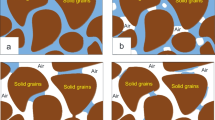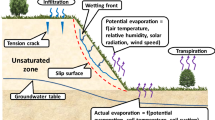Abstract
This paper addresses the time history finite element analysis of rock-structure interaction. Modeled is not only the lateral energy dissipation, but also the interaction between the far field and the numerical model itself. This is accomplished by a preliminary analysis of the far field as a shear beam (for lateral excitation), and then velocities and displacements are transferred to the model as nodal forces through damping and stiffness matrices respectively. Details of the finite element implementation are given, along with an extensive series of simulations comparing this method, with the one of Lysmer for both 2D and 3D models. The model is derived from the principle of virtual work, and its implementation does not require any modification of existing finite element codes, only clever pre and postprocessing of results are needed.
Similar content being viewed by others
Abbreviations
- E :
-
Young modulus
- F :
-
force vector
- C :
-
Damping Matrix
- \({{{\bf C}}^L_i}\) :
-
Lysmer Damping matrix along axis i
- F C :
-
Equivalent nodal forces due to free field velocities
- F K :
-
Equivalent nodal forces due to free field displacements
- F R :
-
Equivalent nodal forces due to free field Rayleigh damping
- K :
-
Stiffness matrix
- M :
-
Mass matrix
- N :
-
Shape functions
- t :
-
Traction vector
- t i :
-
Element size along axis i
- \({{\bf u}, \dot{{\bf u}},\ddot{{\bf u}}}\) :
-
Nodal displacements, velocities and accelerations
- U int :
-
Internal strain energy
- V :
-
Wave velocity
- W ext :
-
External work
- ν :
-
Poisson’s ratio
- λ:
-
Lame parameter
- ρ :
-
Mass density
- μ :
-
Shear modulus
- Γ:
-
Boundary of Ω
- Ω:
-
Element volume
- σ :
-
Stress tensor
References
Basu U, Chopra AK (2004) Perfectly matched layers for time-harmonic elastodynamics of unbounded domains: theory and finite element implementation. Comput Methods Appl Mech Eng 192: 1337–1375
Basu U (2009) Explicit finite element perfectly matched layer for transient three-dimensional elastic waves. Int J Numer Methods Eng 77: 151–176
Bielak J, Christiano P (1984) On the effective seismic input for non-linear soil-structure interaction systems. Earthq Eng Struct Dyn 12: 107–119
Bielak J, Loukakis K, Hisada Y, Yoshimura C (2001) Domain reduction method for three dimensional earthquake modeling in localized regions, part i: theory. Bull Seismol Soc Amer 93(2): 817–824
Cundall P, Hansteen H, Lacasse S, Selnes P (1980) NEESI soil structure interaction program for dynamic and static problems. Tech. Rep. 51508-9, Norwegian Geotechnical Institute
Cundall PA, Kunar R, Marti J, Carpenter P (1979) Solution of infinite dynamic problems by finite element modelling in the time domain. In: Proceedings of the 2nd international conference on applied numerical modelling, Pentech Press, pp 341–351
Ghanaat Y (2004) Failure modes approach to safety evaluations of dams. In: Proceedings of 13th world conference on earthquake engineering, Vancouver, B.C., paper No. 1115
Hudson M, Idriss I, Beikae M (1994) QUAD4M a computer program to evaluate the seismic response of soil structures using finite element procedures and incorporating a compliant base. Tech. rep., Center for Geotechnical Modeling, Department of Civil & Environmental Engineering, University of California, Davis
Japanese Society of Civil Engineers (2000) Dynamic analysis and earthquake resistant design; volume 2 methods of dynamic analysis. Balkema, Section 4.2
Kenkyusho K (1995) Superflush/3d. http://www.flush.co.jp
Lebon G, Saouma V, Uchita Y (2010) 3d rock-dam seismic interaction. Dam Engineering 21
Lemos J (1999) Discrete element analysis of dam foundations. In: Distinct element modelling in geomechanics. Balkema, pp. 89–115
Lysmer J, Drake L (1972) A finite element method for seismology. Methods Comput Phys 11: 181–216
Lysmer J, Kuhlemeyer R (1969) Finite element model for infinite media. ASCE J Eng Mech 95(EM 4): 859–877
Lysmer J, Udaka T, Seed H (1975) FLUSH a computer program for approximate 3d analysis of soil-structure interaction problems. Tech. Rep. UCB/EERC-75/30, Earthquake Engineering Research Center, University of California, Berkeley, CA
Mills-Bria B, Nuss L, Dixon L, Powell C, Harris D, O’Connell D (2006) State-of-practice for the nonlinear structural analysis of dams at the bureau of reclamation. Tech. rep., US Dept. of the Interior, Bureau of Reclamation
Miura F, Okinaka H (1989) Dynamic analysis method for 3d soil-structure interaction systems with the viscous boundary based on the principle of virtual work. Jpn J Civ Eng, pp 395–404
Miura F, Toki K (1987) Estimation of natural frequency and damping factor for dynamic soil structure interaction systems. In: Proceedings of the 3rd international conference on soil dynamics and earthquake engineering, vol 4, 73–87
Saouma V, Červenka J, Reich R (2010) Merlin finite element user’s manual. http://civil.colorado.edu/~saouma/pdf/users.pdf
Schnabel PB, Lysmer J, Seed H (1972) SHAKE a computer program for earthquake response analysis of horizontally layered sites. Tech. Rep. UCB/EERC-72/12, Earthquake Engineering Research Center, University of California, Berkeley, CA
Smith W (1974) A nonreflecting plane boundary for wave propagation problems. J Comput Phys 15: 492–503
Wolf J (1988) Soil-structure interaction analysis in time domain. Prentice-Hall Inc., New York
Zhang Y, Yang Z, Bielak J, Conte J, Elgamal A (2003) Treatment of seismic input and boundary conditions in nonlinear seismic analysis of a bridge ground system. In: Proceedings 16th ASCE engineering mechanics conference, University of Washington, Seattle
Zienkiewicz O, Kelly D, Bettess P, (1979) The sommerfeld (radiation) condition on infinite domains and its modelling in numerical procedures. In: Glowinski R, Lions J, Laboria I (eds) Computing methods in applied sciences and engineering, 1977, I, Lecture notes in mathematics, vol 704. Springer, Berlin/ Heidelberg, pp 169–203
Zienkiewicz OC, Taylor RL, Zhu J (2005) The finite element method for solid and structural mechanics, 6th edn. Elsevier Butterworth-Heinemann, Oxford
Author information
Authors and Affiliations
Corresponding author
Rights and permissions
About this article
Cite this article
Saouma, V., Miura, F., Lebon, G. et al. A simplified 3D model for soil-structure interaction with radiation damping and free field input. Bull Earthquake Eng 9, 1387–1402 (2011). https://doi.org/10.1007/s10518-011-9261-7
Received:
Accepted:
Published:
Issue Date:
DOI: https://doi.org/10.1007/s10518-011-9261-7




